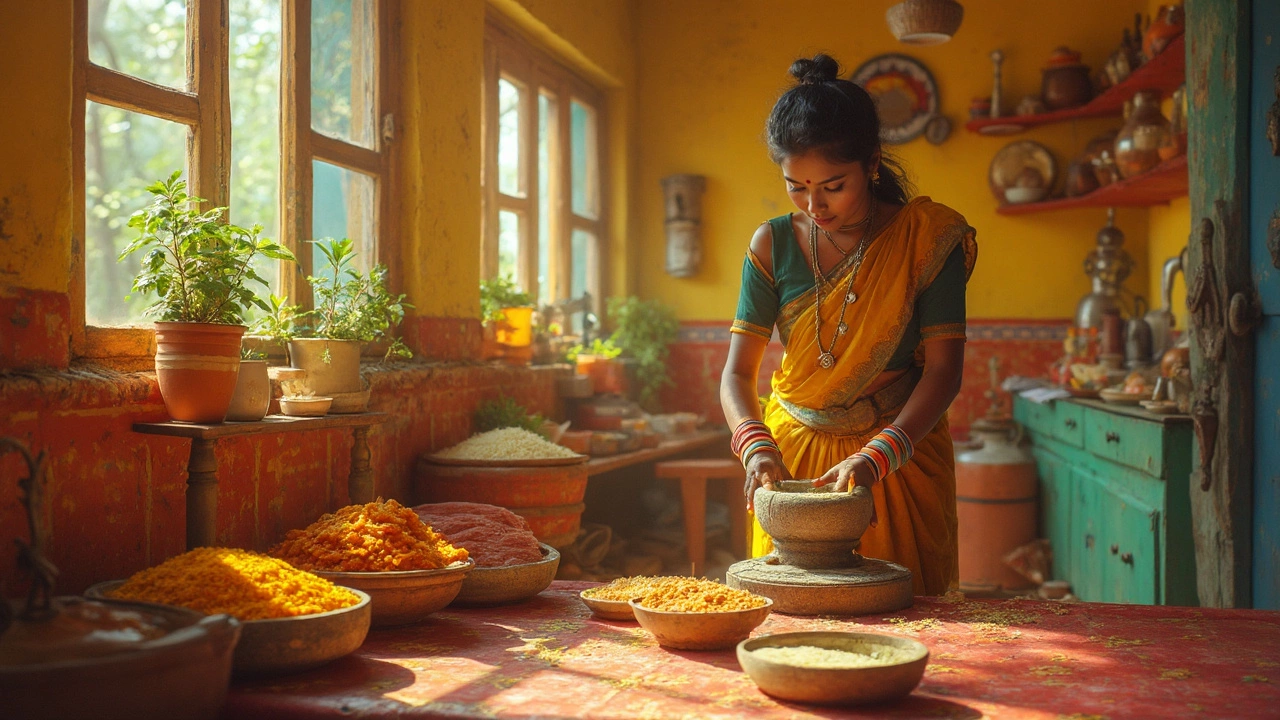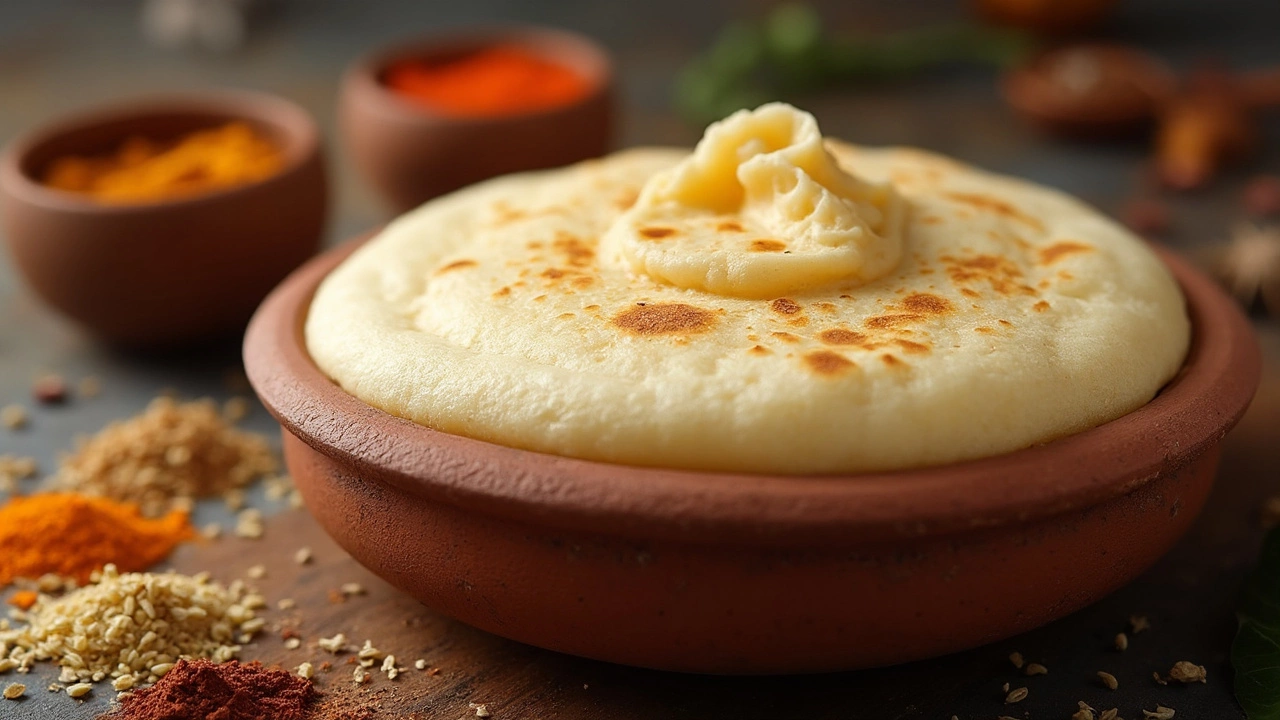Quickly Make Soft Dosa Batter Without Yeast
 Feb, 14 2025
Feb, 14 2025
We all love a good dosa, right? Those crispy edges with the soft, fluffy middle can make any meal special. But what do you do if you want to whip them up fast and don't have yeast? Don't worry, it's easier than you might think.
First off, let's talk about what you need. The key ingredients are rice and urad dal. Pick rice that's short or medium grain, it's better for creating a softer batter. Combining it with split urad dal gives that fluffy texture.
Now, soaking plays a crucial role. For the best results, soak the rice and dal separately in warm water. It speeds up the process. A few hours in warm water can make a huge difference in how they grind.
- Understanding the Ingredients
- Best Types of Rice and Dal
- Soaking Time Hacks
- Blending Techniques
- Fermentation Without Yeast
- Practical Tips for Perfect Dosas
Understanding the Ingredients
When it comes to making dosa batter, knowing your ingredients is half the battle. The two main stars are rice and urad dal. Ever wonder why? Let's break it down.
Rice: The Foundation
Rice gives structure to your batter. It affects the crispiness of your soft dosa and how well it holds together. You want to look for short or medium-grain rice. Basmati is not your buddy here. In fact, a mix of different rice types like regular white rice and parboiled rice often gives the best results.
Urad Dal: The Softener
Split urad dal, also known as black gram, adds the fluff and texture. It's all about getting that perfect soft dosa middle. Make sure you choose good quality, skinless white urad dal for the best results.
If you're exploring substitutes, note that some folks mix in puffed rice for added softness or a handful of cooked rice to enhance fermentation.
The Role of Fenugreek Seeds
Some add a teaspoon of fenugreek seeds while soaking. Why? They help with fermenting and can improve the batter's nutritional profile and taste. Plus, fenugreek seeds are known for adding subtle flavor complexity.
Optional Ingredients
- Puffed rice: For softer texture.
- Cooked rice: Helps in faster and better fermentation.
Understanding these ingredients will help you nail the perfect dosa without needing yeast. The key is in the balance and the quality of what you use. Need a quick cheat sheet? Check this simple table below:
| Ingredient | Purpose |
|---|---|
| Rice | Structure and crispiness |
| Urad Dal | Softness and fluffiness |
| Fenugreek Seeds | Fermentation booster |
| Puffed Rice | Softness enhancement |
Best Types of Rice and Dal
Choosing the right ingredients is the cornerstone for making a great dosa batter. Let's break down which rice and dal work best to churn out those perfect dosas without yeast.
Choosing the Rice
When it comes to rice, go for medium or short-grain varieties. Idli rice is a popular choice because it's slightly starchy, which helps in fermentation and contributes to that desired fluffiness. If you can't find idli rice, parboiled rice works as a good substitute. Steer clear of basmati or jasmine rice as they tend to be too fragrant and don't provide the same texture.
Picking the Dal
The urad dal is what gives the dosa its soft interior. Opt for whole or split urad dal without skin. Using split urad dal helps the batter blend more evenly and speeds up the soaking process. A typical proportion is about 1 cup of dal to 2 to 3 cups of rice. This ratio can be adjusted slightly based on taste and texture but stick close for the best results.
These choices in rice and dal effectively create a balance which results in that crispy-soft texture we all crave in our soft dosas. So next time you're in the grocery store, remember this guide to picking the best ingredients for a quick, yeast-free dosa-making experience.
Soaking Time Hacks
Alright, so you've got your rice and urad dal ready. The next question is, how can you speed things up? Well, the soaking time is something you can tweak to save a few hours.
Typically, the longer you soak, the easier it is to grind, but you don't have to wait for ages. Here's a quick trick: soak the rice and the dal separately in warm water. This little change can cut your soaking time by half.
Why Warm Water Helps
Using warm water isn't just a random thought. It actually softens the grains faster. Aim for water that's about 40-50°C (or 104-122°F). This temperature range supports quick absorption without damaging the grain structure.
Quick Soak Process
Here's a simple guide:
- Start with one cup of rice and half a cup of urad dal.
- Use separate bowls for each and fill them with warm water.
- Soak the rice for about 2-3 hours and the dal for about 1-2 hours.
- This should do the trick for smooth blending.
Bonus Hack: Adding Fenugreek Seeds
If you're looking to enhance the fermentation, toss in a teaspoon of fenugreek seeds with the dal. It aids the fermentation process and adds a lovely golden color to the dosas.
Remember, these soaking time hacks let you whip up soft dosa batter in much less time, without compromising on the texture or taste. No need for overnight commitments when a few hours will work just fine!

Blending Techniques
Perfect dosa batter isn't just about the ingredients. How you blend them really matters. The goal is to get a smooth, airy consistency that’ll give you soft, fluffy results. Here's how you can nail it:
Choosing the Right Blender
Investing in a high-power blender can make all the difference. Traditional stone grinders are great, but modern blenders can do the job just as well, saving both time and effort. Just make sure it's powerful enough to grind the rice and dal smoothly.
Step-by-Step Blending
- Drain the soaked rice and dal separately. You’ll use different blending settings for each, so keep them apart for now.
- Start with the dal. Toss the drained dal into the blender with a small amount of water. Begin at a low speed, gradually increasing it. You’re aiming for a rich, creamy texture.
- Next, it’s time for the rice. Blend with small water increments until you get a fine, sandy texture. Don’t worry about tiny grains — they add an interesting crunch.
Getting the Consistency Right
The dal should feel velvety against your fingers. It’s an indicator that your dosa batter will be soft. With the rice, it’s a slightly grainy texture that’s right. When you combine both, you should end up with a batter that's thick but pourable. If it feels too heavy, add a splash more water.
Tips for Better Blending
- A general trick is to keep the batter cool by adding ice cubes during blending. This helps maintain the texture and prevents it from generating excess heat.
- A pinch of salt before blending can enhance the flavor and even aid in quicker fermentation when you skip yeast.
There you go! With these blending techniques, crafting soft dosas without yeast becomes a breeze. Say goodbye to complex preparations and enjoy delicious dosas anytime!
Fermentation Without Yeast
Making dosa batter without yeast is all about natural fermentation, and it's quite straightforward. The trick lies in using the right conditions. Here's how you can make it happen.
Rely on Temperature
Temperature is your best friend here. For the dosa batter to ferment well and fast, it needs warmth. If you live in a warm climate like Mumbai, lucky you! Just leave the blended dosa batter covered in a warm spot overnight. If it's cooler, you can use the oven, but keep the light on. It creates just enough warmth to help the fermentation process.
Leverage Fermentation Time
Time is crucial too. Typically, for optimal fermentation, the batter needs about 8 to 12 hours. You'll know it's ready when it has doubled in volume and starts showing small bubbles on the surface. These bubbles are a sign that it's airy and will make soft dosa.
Incorporate Fenugreek Seeds
Adding a tiny amount of fenugreek seeds to your mix can turbocharge the fermentation process. Not only do they enhance the batter's nutritional value, but they also help in yielding a perfect consistency for your pancakes.
Monitor and Adjust
Not all days are the same when it comes to the weather. Keep an eye on your batter. Slight changes in aroma or appearance can point out if it needs more time. For troubleshooting, if it's not fermenting, stir it once or twice during the process to let in some air.
Use these tricks to get a soft dosa without any yeast and enjoy those homemade flavors in no time!
Practical Tips for Perfect Dosas
Already got your dosa batter ready? Great! Here are some simple yet effective tips to help you achieve those perfect, delicious dosas.
1. Consistency of the Batter
The right batter consistency is key. If it's too thick, your dosas will be hefty. Too thin, and they'll turn out like paper. Aim for a batter that's thick enough to coat the back of a spoon but still able to spread effortlessly across the pan.
2. Proper Heat
Getting the temperature right is a game-changer. Heat your tawa until it’s hot, then sprinkle some water to bring the temperature down slightly before spreading the batter. This ensures your dosa cooks evenly and crisps up nicely without sticking.
3. Oil the Pan Wisely
Using oil is great, but don't overdo it. A few drops spread with a cloth or onion slice will help your dosa release perfectly. Plus, it adds a nice aroma!
4. Spread Technique
When pouring the dosa batter onto the tawa, spiral outwards quickly but gently. It helps in achieving even thickness and a consistent texture.
5. Flipping the Dosa
Once the edges start to lift and turn golden, you know it's time to flip. Don't rush this. Cooking one side thoroughly before flipping ensures a nice, crisp dosa every time.
6. Serve Immediately
Ever noticed how fresh dosas taste better? Serve them hot, straight off the tawa. Not only do they taste their best, but they maintain that signature crispness.
| Tip | Impact |
|---|---|
| Right Batter Consistency | Easy spreading, uniform cook |
| Proper Heat | Even cooking, better texture |
| Oil Wisely | Non-stick effect, flavor enhancement |
| Immediate Serving | Best taste, perfect crispness |
By following these tips, you'll be flipping perfect, restaurant-style dosa in no time. Go on, give it a try and impress everyone at the dining table!